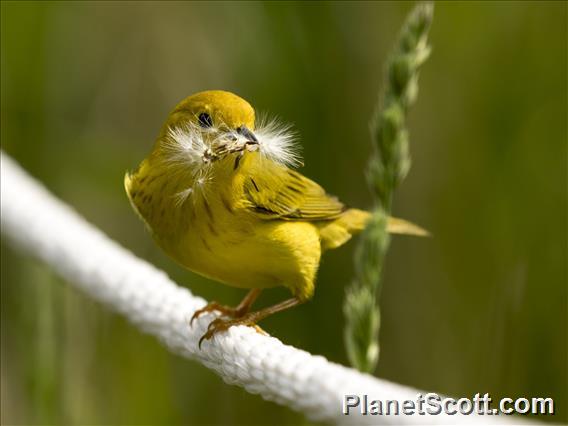Yellow Warbler (Setophaga petechia)

Yellow Warbler (Setophaga petechia)
×


Yellow Warbler (Setophaga petechia)
About Yellow Warbler (Setophaga petechia)
- Kingdom: Animals
- Phylum: Chordates
- Class: Birds
- Order: Perching Birds
- Family: New World Warblers
Please see details, credits, terms of use and the latest version of the map at Discover Life.
Explore Dendroica petechia in Discover Life.
Discover Life and original sources
Lifelists
Trips
Visits
-
2006-09-17Lake Merced , United States of AmericaMany from concrete bridge.
-
2006-11-28Isla Plaza Sur, Ecuador
-
2006-11-30Isla Espanola, Ecuador
-
2006-12-09Isla Santa Cruz - Puerto Ayora, EcuadorOn the breakfast table.
-
2007-04-07Torrey Pines State Reserve, United States of America
-
2008-01-08San Blas Ponds, Mexico
-
2008-02-17San Jose del Cabo - Estuary, Mexico
-
2009-01-14Cozumel, MexicoEspecially common at the Punta Sur Lighthouse
-
2009-01-20Crooked Tree, Belize
-
2009-01-30Semuc Champey, Guatemala
-
2009-02-18Parque National Palo Verde, Costa Rica
-
2009-03-18Mogue, Panama
-
2009-05-09Nelson Lake Forest Preserve, United States of America
-
2012-05-20Pyramid Lake, United States of America
-
2012-07-09Sax-Zim Bog, United States of America
-
2012-07-10Arrowwood NWR, United States of America
-
2012-07-11Theodore Roosevelt National Park - South Unit, United States of AmericaSeen returning to nest repeatedly.
-
2012-07-13Grand Teton National Park, United States of America
-
2013-04-19Bolivar Peninsula, United States of America
-
2013-09-28Presidio - El Polin Spring, United States of America
-
2014-05-11San Pedro RNCA--San Pedro House, United States of America
-
2014-07-16Nome, United States of America
-
2014-07-17Nome--Safety Sound, United States of America
-
2014-07-18Nome-Kougarok Road, United States of America
-
2014-10-02Golden Gate Park - San Francisco Botanical Garden, United States of America
-
2015-05-24Burnidge Forest Preserve, United States of America
-
2015-05-25Montrose Point, United States of America
-
2015-08-22Golden Gate Park - San Francisco Botanical Garden, United States of America
-
2015-10-27Parque Nacional Soberania, Panama
-
2015-10-28Parque Nacional Soberania, Panama
-
2015-10-31El Valle de Anton, Panama
-
2016-01-03Ceiba Natural Reserve, United States of America
-
2016-01-04Cabo Rojo, United States of America
-
2016-01-04La Parguera, United States of America
-
2016-05-06Montrose Point, United States of America
-
2016-07-14Pippy Park, Canada
-
2016-09-18Lake Merced , United States of America
-
2016-09-22Golden Gate Park - North Lake, United States of America
-
2018-07-29Big Bend Yuba River, United States of America
-
2018-09-02Lake Merced , United States of America
-
2018-09-16Golden Gate Park - Stow Lake, United States of America
-
2018-09-20Oceano, United States of America
-
2018-09-24Oceano, United States of America
-
2020-01-30Playa Patzcuaro, Mexico
-
2020-01-31Playa San Pancho, Mexico
-
2021-05-22Illinois Beach State Park, United States of America
-
2021-05-23Illinois Beach State Park, United States of America
-
2021-05-24Montrose Point, United States of America
-
2021-05-26Montrose Point, United States of America
-
2021-05-27Montrose Point, United States of America
-
2021-05-28Montrose Point, United States of America
-
2021-05-29Montrose Point, United States of America
-
2021-06-12Glass Mountains, United States of America
-
2021-09-06Presidio - Fort Scott, United States of America
-
2021-10-08Golden Gate Park - San Francisco Botanical Garden, United States of America
-
2023-05-11Montrose Point, United States of America
-
2023-05-12Montrose Point, United States of America
-
2023-05-12Illinois Beach State Park, United States of America
-
2023-05-15Burnidge Forest Preserve, United States of America
-
2023-09-26Parque Nacional Tortuguero, Costa Rica
-
2023-09-27Parque Nacional Tortuguero, Costa Rica
-
2023-10-04Parque Nacional Volcan Arenal, Costa Rica
-
2024-03-30El Refugio, Mexico
-
2024-03-31Parque Nacional Huatulco, Mexico
-
2024-09-21Presidio - Battery Livingston, United States of America
-
2024-09-24Presidio - Battery Livingston, United States of America
-
2024-10-09Barranquilla Swamp, Colombia
-
2024-10-13Santuario de Fauna y Flora Los Flamencos, Colombia
-
2024-10-14Santuario de Fauna y Flora Los Flamencos, Colombia
-
2025-04-02Pointe Rouge, Martinique
-
2025-04-07Colihaut, Dominica
-
2025-04-08Syndicate Nature Trail, Dominica
-
2025-04-13Codrington, Antigua and Barbuda
-
2025-04-14Codrington, Antigua and Barbuda
-
2025-04-14McKinnon's Pond, Antigua and Barbuda





